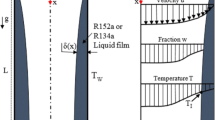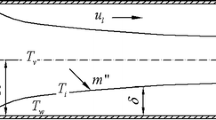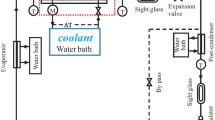Abstract
The condensation pressure drop characteristics for pure refrigerants R22, R134a, and a binary refrigerant mixture R410A without lubricating oil in a single circular microtube were investigated experimentally. The test section consists of 1,220 mm length with horizontal copper tube of 3.38 mm outer diameter and 1.77 mm inner diameter. The experiments were conducted at refrigerant mass flux of 450–1,050 kg/m2s, and saturation temperature of 40°C. The main experimental results showed that the condensation pressure drop of R134a is higher than that of R22 and R410A for the same mass flux. The experimental data were compared against 14 two-phase pressure drop correlations. A new pressure drop model that is based on a superposition model for refrigerants condensing in the single circular tube is presented.













Similar content being viewed by others
Abbreviations
- C :
-
Chisholm parameter
- c p :
-
Specific heat at constant pressure (kJ kg−1 K−1)
- d :
-
Diameter (m)
- dp/dz :
-
Pressure gradient along tube axis (kPa m−1)
- f :
-
Friction factor
- G :
-
Mass velocity (kg m−2 s−1)
- g :
-
Gravitational acceleration (m s−2)
- i fg :
-
Latent heat (kJ kg−1)
- k :
-
Parameter based void fractions
- m :
-
Mass flow rate (kg s−1)
- N :
-
Number of data
- p :
-
Pressure (kPa)
- Q :
-
Heat capacity (kW)
- S :
-
Correlation factor for Chisholm correlation
- T :
-
Temperature (K)
- X :
-
Lockhart-Martinelli parameter
- x :
-
Vapor quality
- z :
-
Length of test section (m)
- Δp:
-
Pressure drop (kPa)
- Bo :
-
Bond number
- f :
-
Friction factor
- Fr :
-
Froude number
- Pr :
-
Prandtl number
- Re :
-
Reynold number
- We :
-
Weber number
- α:
-
Void fraction
- μ:
-
Viscosity (Pa s)
- ρ:
-
Density (kg m−3)
- σ:
-
Surface tension (N m−1), deviation
- Φ2 :
-
Two-phase frictional multiplier
- Ω:
-
Correlation factor for Chen et al. correlation
- ν:
-
Specific volume (m3 kg−1)
- a:
-
Accelerational term
- abs:
-
Mean
- avg:
-
Average
- cal:
-
Calculated
- cs:
-
Source water
- exp:
-
Experimental
- f:
-
Frictional term
- g:
-
Saturated vapor or gas
- H:
-
Homogeneous
- i:
-
Inner, inside
- in:
-
Inlet
- l:
-
Saturated liquid
- lo:
-
Liquid only
- out:
-
Outlet
- pre:
-
Preheater
- r:
-
Refrigerant
- sat:
-
Saturation
- tp:
-
Two-phase
- sub:
-
Subsection
References
Yu W, France DM, Wambsganss MW, Hull JR (2002) Two-phase pressure drop, boiling heat transfer and critical heat flux to water in a small-diameter horizontal tube. Int J Multiph Flow 28:927–941
Chisholm D (1973) Pressure gradients due to friction during the flow of evaporating two-phase mixtures in smooth tubes and channels. Int J Heat Mass Transf 16:347–358
Koyama S, Kuwara K, Nakashita K (2003) Condensation of refrigerant in a multi-port channel. International conference on microchannels and minichannels, Rochester, pp 193–205
Friedel L (1979) Improved friction pressure drop correlation for horizontal and vertical two-phase pipe flow. Eur Two-phase Flow Group Meet Pap E2(18):485–492
Friedel L (1980) Pressure drop during gas/vapor–liquid flow in pipes. Int J Chem Eng 20:352–367
Mishima K, Hibiki T (1996) Some characteristics of air–water two-phase flow in small diameter vertical tubes. Int J Multiph Flow 22:703–712
Cavallini A, Del Col D, Matkovic M, Rossetto L (2009) Frictional pressure drop during vapour–liquid flow in minichannels: modelling and experimental evaluation. Int J Heat Fluid Flow 30:131–139
Zhang M, Webb RL (2001) Correlation for two-phase friction for refrigerants in small-diameter tubes. Exp Therm Fluid Sci 25:131–139
Tran TN (1998) Pressure drop and heat transfer study of two-phase flow in small channels. PhD dissertation, Texas Tech University, Lubbock, TX
Chen IY, Yang KS, Wang CC (2002) An empirical correlation for two-phase frictional performance in small diameter tubes. Int J of Heat Mass Transf 45:3667–3671
Souza DAL, Pimenta MDM (1995) Prediction of pressure drop during horizontal two-phase flow of pure and mixed refrigerants, in: Proceedings of the 1995 ASME/JSME fluids engineering and laser anemometry conference and exhibition, August 13–18, Hilton Head, SC, ASME, New York, NY, pp 161–171
Zhang W, Hibiki T, Mishima K (2010) Correlations of two-phase frictional pressure drop and void fraction in mini-channel. Int J Heat Mass Transf 53:453–465
Lemmon EW, Huber ML, McLinden MO (2007) Reference fluid thermodynamic and transport properties, NIST standard reference database 23 Version 8.0
Kline SJ, McClintock FA (1953) Describing uncertainties in single sample experiments. Mech Eng 75:385–387
Suo M, Griffith P (1964) Two-phase flow in capillary tubes. J Basic Eng 86:576–582
Barnea D, Luninski Y, Taitel Y (1983) Flow pattern in horizontal and vertical two phase flow in small diameter pipes. Can J Chem Eng 61:617–620
Damianides C, Westwater JW (1998) Two phase flow patterns in a compact heat exchanger and in small diameter tubes. In: Proceedings of second U. K. national conference on heat transfer, vol II, Glasgow, Scotland, pp 1257–1268
Fukano T, Kariyasaki A, Kagawa M (1989) Flow patterns and pressure drop in isothermal gas-liquid concurrent flow in a horizontal capillary tube. In: ANS proceedings 1989 national heat transfer conference 4:153–161
Soliman HM (1986) Mist-annular transition during condensation and its influence on the heat transfer mechanism. Int J Multiph Flow 12:277–288
Coleman JW, Garimella S (2000) Two-phase flow regime transitions in microchannel tubes: the effect of hydraulic diameter. ASME HTD 366–4:71–83
Garimella S (2004) Condensation flow mechanisms in microchannels: basis for pressure drop and heat transfer models. Heat Transfer Eng 25:104–116
Matkovic M, Cavallini A, Del Col D, Rossetto L (2009) Experimental study on condensation heat transfer inside a single circular minichannel. Int J Heat Mass Transf 52:2311–2323
Wambsganss MW, Jendrzejczyk JA, France DM (1991) Two-phase flow patterns and transitions in a small, horizontal, rectangular channels. Int J Multiph Flow 3:327–342
Dalkilic AS, Wongwises S (2009) Intensive literature review of condensation inside smooth and enhanced tubes. Int J Heat Mass Transf 52:3409–3426
Zivi SM (1975) Estimation of steady-state steam void-fraction by means of the principle of minimum entropy production. Trans ASME J Heat Transf C 86:247–252
Rigot G (1973) Fluid capacity of an evaporator in direct expansion, Plomberie, 328:133–144, (English translated, ORNL-tr-5217, Oak Ridge National Laboratory, Oak Ridge, TN)
Smith SL (1969) Void fractions in two-phase flow: a correlation based upon an equal velocity head model. Proc Inst Mech Eng 36:647–664
Levy S (1960) Steam slip theoretical prediction from momentum model. Trans ASME J Heat Transf C 82:113–124
Fauske H (1961) Critical two-phase, steam–water flows. In: Proceedings of the 1961 Heat Transfer and Fluid Mechanics Institute, Stanford University Press, Stanford, CA, USA, pp 79–89
Thom JRS (1964) Prediction of pressure drop during forced circulation boiling of water. Int J Heat Mass Transf 7:709–724
Baroczy CJ (1965) Correlation of liquid fraction in two-phase flow with application to liquid metals. Chem Eng Prog Symp Ser 61(57):179–191
Madsen N (1975) A void fraction correlation for vertical and horizontal bulk-boiling of water. AIChE J 21:607–608
Ahrens FW (1980) Heat pump modeling, simulation and design. In: Proceedings of the NATO advanced study institute on heat pump fundamentals, Espinho, Spain
Spedding PL, Spence DR (1989) Prediction of holdup in two phase flow. Int J Eng Fluid Mech 2:109–118
Chen JJJ (1986) A further examination of void-fraction in annular two-phase flow. Int J Heat Mass Transf 29:1760–1763
Lockhart RW, Martinelli RC (1949) Proposed correlation of data for isothermal two-phase, two-component flow in pipes. Chem Eng Prog 45:39–48
El Hajal J, Thome JR, Cavallini A (2003) Condensation in horizontal tubes. Part 1: two-phase flow pattern map. Int J Heat Mass Transf 46:3349–3363
Turner JM, Wallis GB (1965) The separate-cylinders model of two-phase flow, paper no. NYO-3114-6. Thayer’s School Eng, Dartmouth College, Hanover, NH, USA
Wallis GB (1965) One-dimensional two-phase flow. McGraw-Hill, New York, pp 51–54
Domanski P, Didion D (1983) Computer modeling of the vapor compression cycle with constant flow area expansion device. NBS Building Sci Ser 155
Yashar DA, Newell TA, Chato JC (1998) Experimental investigation of void fraction during horizontal flow in smaller diameter refrigeration applications, ACRC TR-141. Air Conditioning and Refrigeration Center, University of Illinois, Urbana-Champaign, IL
Wilson MJ, Newell TA, Chato JC, Infante Ferreira CA (2003) Refrigerant charge, pressure drop and condensation heat transfer in flattened tubes. Int J Refrig 26:442–451
Premoli A, Francesco D, Prima A (1970) An empirical correlation for evaluating two-phase mixture density under adiabatic conditions. In: European two-phase flow group meeting, Milan, Italy
Kawahara A, Kawaji M, Chung PMY, Sadatomi M, Okayama K (2005) Effects of channel diameter and liquid properties on void fraction in adiabatic two phase flow through microchannels. Heat Transf Eng 26:13–19
Graham D, Chato JC, Newell TA (1999) Heat transfer and pressure drop during condensation of refrigerant 134a in an axially grooved tube. Int J Heat Mass Transf 42:1935–1944
Hughmark GA (1962) Holdup in gas–liquid flow. Chem Eng Prog 58:62–65
Hamersma PJ, Hart J (1987) A pressure drop correlation for gas/liquid pipe flow with a small liquid holdup. Chem Eng Sci 42:1187–1196
Bankoff SG (1960) A variable density single-fluid model for two-phase flow with particular reference to steam-water flow. Trans ASME J Heat Transf 82:265–272
Czop V, Barbier D, Dong S (1994) Pressure drop, void fraction and shear stress measurements in adiabatic two-phase flow in coiled tube. Nucl Eng Des 149:323–333
Tandon TN, Varma HK, Gupta CP (1985) A void fraction model for annular two-phase flow. Int J Heat Mass Transf 28:191–198
Huq RH, Loth JL (1992) Analytical two-phase flow void fraction prediction method. J Thermo Phys 6:139–144
Armand AA (1946) The resistance during the movement of a two-phase system in horizontal pipes. Izv Vses Teplotekh Inst 1:16–23 AERA-Lib/Trans 828
Chisholm D, Laird ADK (1958) Two phase flow in rough tubes. Trans ASME 80:276–286
Steiner D (1993) Heat transfer to boiling saturated liquids, VDI-Warmeatlas (VDI Heat Atlas). Verein Deutscher Ingenieure, VDI-Gessellschaft Verfahrenstechnik und Chemie-ingenieurwesen (GCV) (eds), (translator: J. W. Fullarton, Dusseldorf)
Harms T, Eckart D, Groll A, Braun J (2003) A void fraction model for annular flow in horizontal tubes. Int J Heat Mass Transf 46:4051–4057
Chisholm D (1983) Two phase flow in pipelines and heat exchangers. George Godwin in Association with the Institution of Chemical Engineers, London
Armand AA, Treschev GG (1964) The resistance during the movement of a two-phase system in horizontal pipes. Izv Vse Tepl Inst 1:16–23
Kandlikar SG, Garimella S, Li D, Colin S, King MR (2006) Heat transfer and fluid flow in minichannels and microchannels, 1st edn. Elsevier, Amsterdam, pp 265–281
Dalkilic AS, Agra O, Teke I, Wongwises S (2010) Comparison of frictional pressure drop models during annular flow condensation of R600a in a horizontal tube at low flux and of R134a in a vertical tube at high mass flux. Int. J. of Heat and Mass Transf 53:2052–2064
Coleman JW, Garimella S (2003) Two-phase flow regimes in round, square and rectangular tubes during condensation of refrigerant R134a. Int J Refrig 26(1):117–128
Kim HY, Koyama S, Matsumoto W (2001) Flow pattern and flow characteristics for counter-current two-phase flow in a vertical round tube with wire-coil inserts. Int J Multiph Flow 27:2063–2081
Tran TN, Chyu MC, Wambsganss MW, France DM (2000) Two-phase pressure drop of refrigerants during flow boiling in small channels: an experimental investigation and correlation development. Int J Multiph Flow 26:1739–1754
Wang HS, Rose JW, Honda H (2003) Condensation of refrigerants in horizontal microfin tubes: comparison of correlations for frictional pressure drop. Int J Refrig 26:461–472
Chung PMY, Kawaji M (2004) The effect of channel diameter on adiabatic two-phase flow characteristics in microchannels. Int J Multiph Flow 30:735–761
Triplett KA, Ghiaasiaan SM, Abdel Khalik SI, LeMouel A, McCord BN (1999) Gas–liquid two-phase flow in micro channels. Int J Multiph Flow 25:395–410
Wijaya H, Spatz MW (1995) Two-phase flow heat transfer and pressure drop characteristics of R-22 and R-32/R125. ASHRAE Trans 118:1020–1027
Torikoshi K, Ebisu T (1993) Heat transfer and pressure drop characteristics of R-134a, R-32 and a mixture of R-32/R-134a inside a horizontal tube. ASHRAE Transact Res 99(2):90–96
Cavallini A, Censi G, Del Col D, Doretti L, Longo GA, Rossetto L (2001) Experimental investigation on condensation heat transfer and pressure drop of new HFC refrigerants (R134a, R125, R32, R410A, R236ea) in a horizontal smooth tube. Int J Refrig 24:73–87
Ebisu T, Torikoshi K (1998) Heat transfer characteristics and correlations for R-410A flowing inside a horizontal smooth tube. ASHRAE Trans 121:556–561
Cavallini A, Del Col D, Doretti L, Matkovic M, Rossetto L, Zilio C (2005) Two-phase frictional pressure gradient of R236ea, R134a and R410A inside multi-port mini-channels. Exp Therm Fluid Sci 29:861–870
Chen SL, Gerner FM, Tien CL (1987) General film condensation correlations. Exp Heat Transf 1:93–107
Chen IY, Yang KS, Chang YJ, Wang CC (2001) Two-phase pressure drop of air-water and R-410a in small horizontal tubes. Int J Multiph Flow 27:1293–1299
Cavallini A, Censi G, Del Col D, Doretti L, Longo GA, Rossetto L (2002) Condensation of halogenated refrigerants inside smooth tubes. HVAC R Res 8:429–451
Garimella S (2005) Condensation flow mechanisms, pressure drop and heat transfer in microchannels. In: Kakac S, Vasiliev LL, Bayazitoglu Y, Yener Y (eds) Microscale heat transfer-fundamental and applications. Kluwer Academic Publishers, The Netherlands
Garimella S, Agarwal A, Killion JD (2005) Condensation pressure drop in circular microchannels. Heat Transf Eng 26:1–8
Lee HJ, Lee SY (2001) Pressure drop correlations for two-phase flow within horizontal rectangular channels with small heights. Int J Multiph Flow 27:783–796
Yan YY, Lin TF (1999) Condensation heat transfer and pressure drop of refrigerant R134a in a small pipe. Int J Heat Mass Transf 42:697–708
Yang CY, Lin TY (2007) Heat transfer characteristics of water flow in microtubes. Exp Therm Fluid Sci 32:432–439
Author information
Authors and Affiliations
Corresponding author
Rights and permissions
About this article
Cite this article
Son, CH., Oh, HK. Condensation pressure drop of R22, R134a and R410A in a single circular microtube. Heat Mass Transfer 48, 1437–1450 (2012). https://doi.org/10.1007/s00231-012-0990-1
Received:
Accepted:
Published:
Issue Date:
DOI: https://doi.org/10.1007/s00231-012-0990-1




